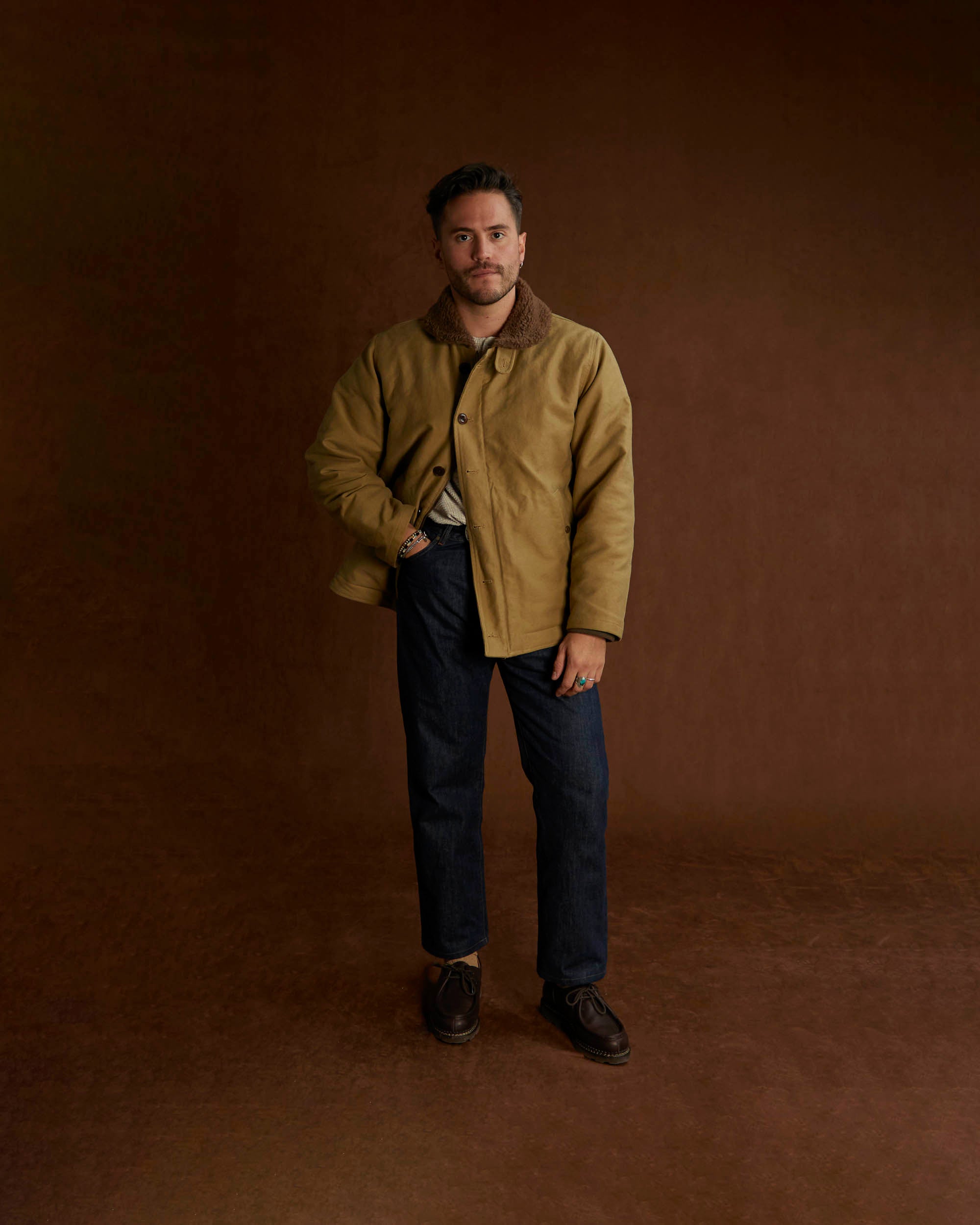Finding the right fit for your jeans isn't just about "fit" or "loose fit." In this article, we'll take an in-depth look at the key differences between fits, teaching you how to understand a measurement chart.
If you want to see even more episodes, for simple and fun tips, here is the link.
Distinguish "straight/tapered" from "narrow/wide"
Usually, it's the misuse of terms that creates confusion when it comes to fit . If I say "straight jeans" or "straight cut" what do you think of? A loose fit that falls a bit like a bag?
Actually, that's not what it means. "Straight" means that the cut narrows very little from the knee. The opposite of straight is "tapered", so a cut that narrows more strongly from the knee, which in English is "tapered".

© Edwin
A pair of jeans with a "tapered" cut.

© Edwin
A pair of "straight" cut jeans.
To distinguish the volume of the thigh from the lower leg taper, normally, we are supposed to use two words in a jean cut.
- One for the upper leg, from loosest to narrowest it would be: Loose - Relaxed - Regular - Slim - Tight - Skinny
To give you an idea of a size 30 jean, a “slim” thigh is somewhere around 31cm , measured flat from the crotch. At 35cm you are on very loose, relaxed, and at 28cm you are on very very skinny.
- Two for the lower leg, it goes from: Flared - Wide - Straight, therefore straight - and “Tapered”, tapered.
Here again, to give an order of magnitude, on a size 30 we start to be on “straight” from an opening of 19cm, again measured flat.

© Strollers
Credit: Strollers
At 23cm you are definitely “wide”, and at 16cm you are guaranteed to have molded calves. However, it is still necessary to qualify, this is sometimes not entirely the reality.
The names of the cuts are misleading
To begin with, these adjectives designate a “rendering” rather than a measure ; they are to be interpreted in relation to the other adjective.
Example: if I have a very tight thigh of 28cm, an opening at 18 will be downright “straight” compared to the thigh, so it is legitimate for the jeans to be called “skinny straight”, even if it is only “18cm”.
Conversely, on a mega wide thigh cut, 19cm, normally a “straight” opening, it can make a very “tapered” opening, hyper-tapered in proportion.
This nuance would still be manageable if the brands had not decided to appropriate different definitions for each type of cut.
So you'll sometimes see haircuts called "straight tapered" when it's literally an oxymoron. Sometimes single adjective nouns and terms that come out of nowhere.
Conclusion: EVERYONE does whatever they want .
Tips for finding your way around
We have two tips for you.
The first is to take your actual thigh measurement where the crotch of a pair of jeans would end, at the top of the leg. Divide it by two, and use that number when looking at a measurement chart.

Results :
- Tell yourself that if the measurement is equal to this number +0cm, the result will be ultraskinny, even after relaxation.
- When you are at +1.5cm, the cut will still be very slim, but not necessarily unbearable.
- At +3cm, you will start to be more comfortable.
- Finally at +5cm, you will be very wide.
For the second tip, hold on tight, you need to take the measurement of your half-thigh as well as the opening as explained earlier. You divide the flat opening by the thigh (for example, 19cm / 32cm.).

© Strollers
Credit: Strollers
Results :
- If you get a number between 0.59 and 0.61, you are on a rather “straight” cut, which tightens little from the knee.
- If you're below 0.56, the fuselage starts to get very marked.
- Beyond 0.64, you will have width at the bottom of the legs.
To be honest, I haven't been able to test it exhaustively. If you have been able to test it, let me know in the comments if the results are right for your jeans.
Understanding Waist Size
It is important to understand that there is a major difference between a "jean size" and a "jean cut". A cut is more or less wide, narrow, straight or tapered depending on the measurements it has for a given waist size .
A waist measurement is also quite standardized, let me explain:
Jeans are often in US sizes, and a size “30” is 30 inches, or 30 inches, and is supposed to fit someone with a 30 inch waist.

Except that this does not mean that the circumference of the jeans will actually be 76.5 cm. In order not to suffocate when putting them on, they may be 1 or 1.5 cm longer to accommodate you, depending on the thickness of the fabric and its rigidity for example.
Then, the problem is that this system dates back to the time when there was only one way to wear jeans and all pants: at the natural high waist, therefore between the floating ribs and the navel .

You have surely noticed that over the decades, the way of wearing jeans has diversified, notably with the arrival of low-rise, mid-rise, etc. However, depending on the height at which the jeans are supposed to be worn, you will have a different measurement to fit the same physique.
The lower the jeans are worn, the more the measurement will increase. It is not uncommon to end up with a 5cm difference between a pair of jeans worn low-rise and a pair worn high-rise.
Add to that the famous “vanity sizing” which gradually increased the sizes over the decades because customers were happy when they fit into a smaller size… Now you understand why it is no longer so standardized.
The best thing to do is to first measure a pair of jeans that fit you using the most common method, which is supposed to give a “half waist measurement” when laid flat.

© Strollers
Credit: Strollers
Please note that this is the measurement that suits you for this wear and this precise waist height.
Also note that the front fork height is the most determining factor in where the size will be placed. However, this is not a measurement that brands often provide .

Balancing the morphology with the cut
Honestly, I think that the cut of jeans will always be a subject of debate. In the end, people wear jeans cuts more for the gender, for the style it gives them than for physical balance.
My personal approach is rather to seek to harmonize the body through clothes, it's not that complicated:
- If you are very short , choose a higher-waisted pair of jeans.
- If you are very tall, choose jeans with a lower waist.
- If you have wide thighs, choose a body that is not too pronounced or even almost straight, otherwise the narrow opening will accentuate the thighs by comparison effect.
- If you have thin thighs, choose a slightly more pronounced taper, precisely because it suits you to make the shin appear thinner.
Finally, the thickness and look of denim means you can afford to go for a more fitted fit than you would with trousers or chinos.
It's not for nothing that the slim fashion started with jeans in the first place. Typically, my jeans are 1 to 1.5 cm less in the mid-thigh than my more dressy pants.
In general, no matter your body type, avoid being completely molded into your jeans, from a pure “balance” point of view it is not advantageous for any physique.
So now you know the basics of jean cuts, assuming a standard length and a common approach to clothing cuts. I find this more effective than going around assigning you cut names because you are “fat/tall/short/skinny” when in practice each of these words can refer to a lot of different physiques.
Be aware, however, that all of this can be nuanced by the length of the pants AND the type of shoes you wear, which I explain to you in a dedicated episode.















